Biotensegrity—Another Way to Understand Your Body
In our culture a loss of up to 50% of the height of the discs as we age from our twenties to our fifties is considered normal. It follows that the herniations, nerve pain, and arthritic change that accompanies this chronic degeneration of our discs is also not seen as unusual. Pain and reduced ability to function is normalized.
It doesn’t have to be this way. In the Bhil tribe in central India, the average disc height of the discs of people in their fifties was discovered to be the same as those in people in their twenties¹, as detailed in Esther’s book, 8 Steps to a Pain-Free Back. It is their habit to actively maintain the length of their spines whenever they do anything that might otherwise compress their discs.
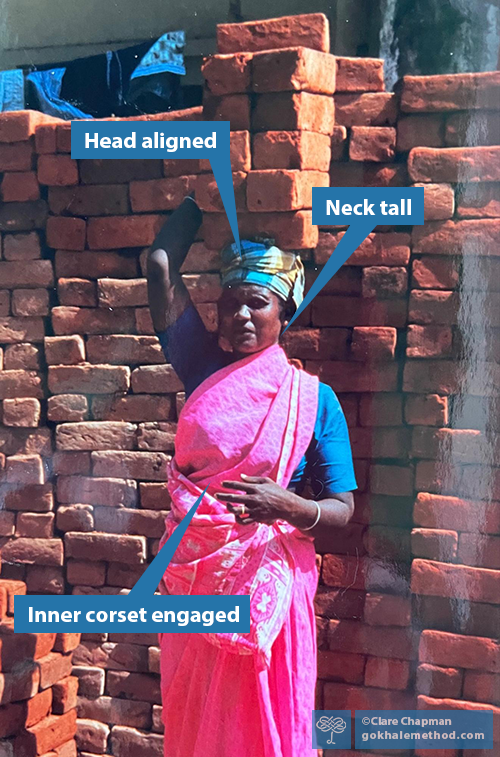
The human spine is able to carry considerable loads without damage—when length is actively maintained.
Maintaining healthy discs requires a healthy J-spine and the engagement of a matrix of muscles—which we refer to in the Gokhale Method as the inner corset. This muscle recruitment and more is taught in our in-person Foundations course, one-day Pop-up course, our online Elements course, plus our Gokhale Active program. The inner corset performs two main actions: a strong engagement of the deepest spinal muscles, and a strong engagement of the deeper layers of abdominal muscles. Together they create length and stability in and around the spine, thus preserving the height of each disc and protecting them against wear and tear. When we make recruitment of our inner corset a habit, every time the spine would otherwise be challenged and damaged, the spine is strengthened and made more resilient.
The effect of engaging the deep abdominal muscles is easy to understand. It’s similar to wearing an external corset, or weightlifting belt, that makes our torso a thinner cylinder. We are mostly made of water, which does not compress easily, so as we squeeze our torso it gets thinner and that fluid has to go somewhere—so it makes us taller, increasing or at least maintaining disc height.
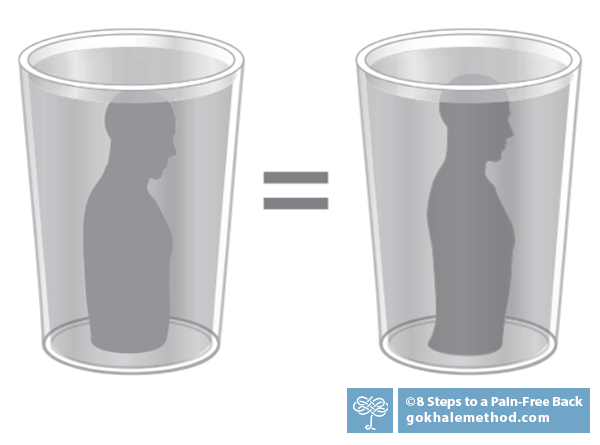
As your torso gets more slender, it must get taller because its volume stays the same.
The action of the deep spinal muscles along the spine is however somewhat counter intuitive. When muscles engage, they contract, becoming shorter. How can that lengthen the spine?
The answer is tensegrity, a word coined from the phrase “tensional integrity”. This is a new word for something very old. If you have ever pitched a tent, that is, almost, a tensegrity structure. The poles are compressed and kept stable by a general tautness, or tension, of the tent fabric. If you leave the tent fabric loose, or leave a guy rope slack, the tent will easily fall down or blow over. But with good all-round tension the tent can resist gravity and additional forces.
In a true tensegrity structure the poles, or bones—whatever is being compressed—do not touch each other. They float as islands of compression in a sea of tension. The simplest example of this is the tower of string, demonstrated below in a short video.
Tensegrity offers an alternative model of structural support. The string is compressing the semicircular strips of plastic which are trying to straighten, putting the string under tension—now even a piece of string can stand up straight!
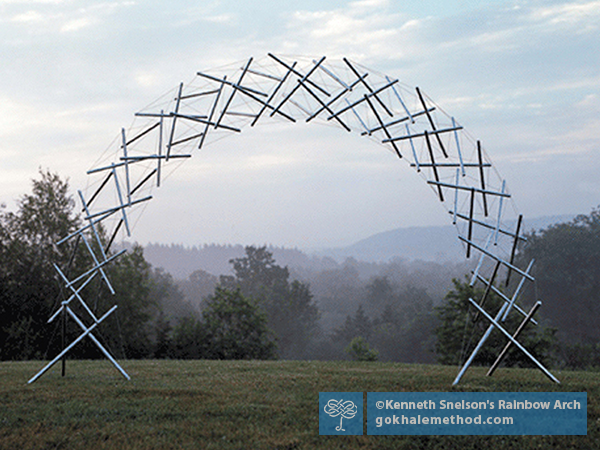
This striking structure, Kenneth Snelson’s Rainbow Arch, is made from metal poles—islands of compression—and wire—the sea of tension. None of the poles touch each other, as with the bones in our bodies (in their natural healthy state).
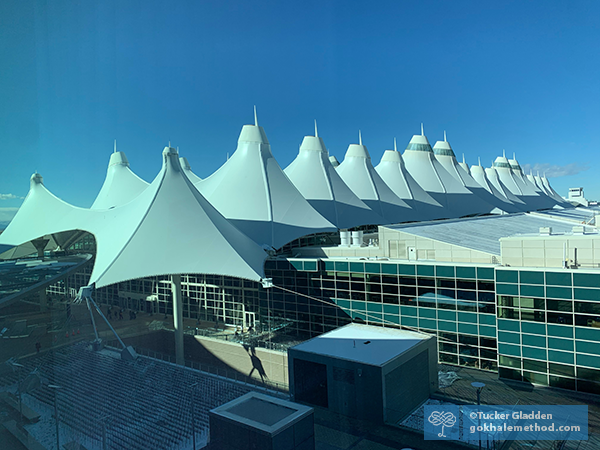
The roof of the Denver airport uses fiberglass and steel cables in a tensegrity design to create a striking structure that is strong and lightweight, covers 300 x 1000 ft, and is evocative of First Nation teepees. It is modern, but native Americans have been pitching teepees using this principle for millennia.
The human spine is a sophisticated tensegrity structure, or more accurately, a biotensegrity structure, part of a living organism. The wood and fine string model in the video below shows how the bones and deepest muscles use the biotensegrity effect. Engaging the muscles increases the biotensegrity effect and the bones actively “float” apart, increasing space for each disc, the overall length of the spine, and its ability to bear load.
This simple wood and string model demonstrates the tensegrity principle, showing how the tendons and muscles can suspend the bones of the spine.
An electromyographic study of the rotatores muscles, the deepest on the spine, confirms this. The rotatores run the length of the spine connecting each vertebra to the next on both sides of the spine. If you engage the rotatores on one side, they assist in spinal rotation. Engage the rotatores on both sides, and the spine lengthens.
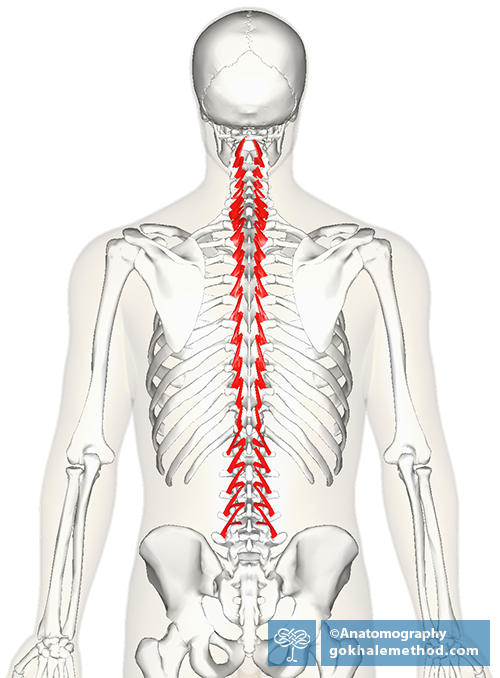
The rotatores muscles—small, deep muscles which attach each vertebra to the next—
were thought to be the main rotators of the spine. Their larger role in fine movement, stabilization, and extending the spine is now better understood.
Our bodies have many fluid-filled spaces contained in “bags” or pockets of elastic material, fascia, where fluid pressure works with healthy tension in the tissues. We also have various “guy ropes” among our fascia, muscles, and tendons, and some are self-tensioning. This makes biotensegrity very elegant and dynamic.
Though it can be difficult to imagine biotensegrity, instruction from a Gokhale Method® teacher makes learning the inner corset very doable. You can lengthen and protect your spine in any number of situations: carrying shopping, running, cycling on rough ground, high-diving, being on a bumpy car ride—the list is almost endless—as are the benefits for your body.
References:
1. Fahrni, W. Harry and Trueman, Gordon E. (1965): Comparative Radiological Study of the Spines of a Primitive Population with North Americans and Northern Europeans, The Journal of Bone and Joint Surgery, 47-B (3): 552.
Best next action steps
If you would like help integrating your structure through healthy posture, get started by booking a consultation, online or in person, with one of our teachers.
You can sign up below to join any one of our upcoming FREE Online Workshops…

Comments
The tensegrity structure is…
The tensegrity structure is fascinating and descriptive. My orthopedic surgeon (talked me into trying alternatives to surgery first which led to stumbling on the Gokhale method), described how my tent pole and tie downs could cause problems. Seeing this article the ‘tent pole’ videos clarified so much for me. I have avoided surgery by following the Gokhale method for five years. Thank you for giving me the ability to put one foot in front of the other without pain, on life’s journey.
Thank you John & team for…
Thank you John & team for this excellent article, videos, and visuals. Beautifully done!
This is so excellent! I want…
This is so excellent! I want to show it to everyone I know. Thank you for posting.
Marian Fredal
Thanks John for these…
Thanks John for these descriptive explanations.
I can only speak for myself, but seeing pictures of the 'naked' bone structure of a spine, I imagined the bones like a pile of bricks, just connected by the disks as buffers. Only now I really understand the importance of the muscles which are so difficult to draw, especially on paper where we have just two dimensions.
From now on I will think more about all the small and important muscles when I do my exercises to strengthen them.
Enjoy pain-free movements!
Matthias from Switzerland
Add New Comment
Login to add commment
Login